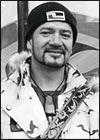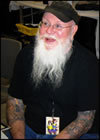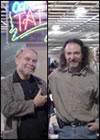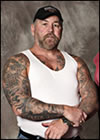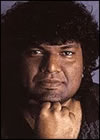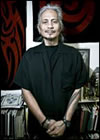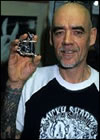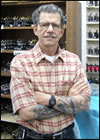|
|
|
|
|
Tattoo Chronicles << 101 Most Influential People in Tattooing << #40-#31 |
Top 101 Most Influential People in Tattooing
Tattooing has undergone enumerable changes over the last few years. An infinite number of shops and products have flooded the market. The fact is, this ancient art form just ain’t what it used to be. Old-style, toss-the-dirty-needles-in-a-bucket tattoo shops down by the waterfront have been replaced by artfully conceived showplaces, complete with rugs on the floor, TV monitors and state-of-the-art sound systems. No more bricks through the windows of competing shops. Las Vegas, Nevada, for example, once off-limits to expansion, is now home for over two hundred purveyors of the art form. So, what with new shops still opening every day and the road leading farther and farther away from its sources, what holds the industry together, in these times of watered-down overabundance ? The people on this very list, that’s who. Each person, here enshrined, has made a significant contribution to the relevance and historic importance of the 5,000-year-old art form. From Number 101 to Number 1, may their importance never be diminished and their contributions never be forgotten. —Bob Baxter  |
|
40. Danielle Oberosler - (www.thetattooroom.com) Danielle’s first writing assignment for Skin&Ink was an “On the Road” column with Erika Stanley. Irreverent and funny, Danielle continued to demonstrate her exceptional reporting skills, authoring a popular monthly column she called “Spotlight.” Showcasing new and relatively undiscovered talent among the worldwide tattoo community, many upcoming young artists owe their blossoming careers to Danielle’s informative and entertaining biographies. Currently the owner/operator of the Tattoo Room in Simi Valley, Oberosler is no stranger to challenges. Her switch from pushing ink in the heart of SoCal tattooing at an upstairs cubbyhole on Melrose Avenue to her partnership with Robert Atkinson at their own shop in the San Fernando Valley was met with daunting obstacles. It is never easy for a female tattooist trying to claim a foothold in an industry dominated by men, especially when Danielle and Robert tried to open their dream tattoo parlor in this super-conservative, “please, don’t rock the boat” neighborhood of Valencia, California. It came to a head when, with over one-hundred-and-fifty “witnesses” to the duo’s talent, ethics and business acumen in attendance, the city fathers put the kibosh on their plans. Never thwarted, Danielle found another location in a friendlier San Fernando Valley city and was moved in and ready to go (with Robert) within weeks. Not to last. Because of some wording or lack of it in the lease agreement, Oberosler was, once again, uprooted and looking for a place to go. Stubborn and, at the same time, rightfully convinced she deserved a shop of her own, Danielle brushed aside warnings from local tattoo-shop-owning bikers and opened a spiffy new parlor near the beautiful borderline of suburban Simi Valley. A world-class graphic artist, Danielle is a one of the industry’s leading role models, especially when it comes to perseverance, dedication and an unshakeable belief in oneself and their art. |
|
39. Henning Jorgenson (www.royaltattoo.com) met Don Ed Hardy, at the 1984 Buxton Convention in England, where Henning received his first Hardy tattoo. From that moment on, Jorgenson’s passion for large-scale Japanese work had no limits. The Japanese irezumi (literally, “insertion of ink”) had a magic and beauty that Henning found irresistible. One of his major influences was Bob Roberts. “Bob came to Copenhagen in 1982, worked with Tattoo Svend, and started a big dragon backpiece on me,” says Henning. “Bob made tattooing look so easy. His dragons and tigers inspired me to work harder—and larger.” Mike Malone and Kandi Everett traveled Europe in the early ’80s, where Everett inked a skull on Henning’s chest. Greg Irons, who Henning met at the 1984 Amsterdam Convention, was another big influence. “Greg showed a simple cartoony style,” says Henning. “I’d never seen an anything like it before.” In 1983, Henning moved thirty miles north of Copenhagen to Helsingor and opened Royal Tattoo. From the first, Henning specialized in traditional Japanese-style tattooing. He works in other styles too and is fond of old-school designs, but Japanese tattooing is his favorite. In 1986, after enjoying the New Orleans Convention, Henning flew to San Francisco, where, in an epic three-day session, Hardy tattooed a samurai and phoenix on Henning’s ribs. Henning also met Bill Salmon and the nineteen-year-old Filip Leu in Hardy’s old shop. During this San Francisco visit, Henning also hung out with Sailor Cam, Henry Goldfield and Greg Kulz, who soon started working at Erno’s rocking shop at Haight and Fillmore. The San Francisco tattoo renaissance was in high gear and Henning dug it all. In 1987, Henning continued his quest by flying to Seattle, where he worked with P.A. Stephens and Sailor Cam, making tattoo machines at the Seattle Tattoo Emporium, started by Danny Danzel. Henning also worked with Sailor Cam and Paul Rogers in Florida, talking history, making machines, always curious. “That was a once-in-a-lifetime experience,” says Henning. “Paul Rogers was a fantastic host.” Meeting Paul Jeffries at Smiling Buddha in Calgary, Canada was a major event for Henning. Back in San Francisco, Henning soaked up more West Coast styles. Chuck Eldridge related colorful lore during all-night gab sessions. Captain Don dropped in, too, spinning tales of sideshow glory. One of Europe’s leading tattooists, Henning is one of the tattoo’s leading representatives, not only for his talent, but his knowledge and the relationships he has cultivated within the worldwide tattoo scene. Henning Jorgenson is truly one of the art’s foremost international ambassadors. |
|
38. Gordon Toi Hatfield (gordon.toi@ihug.co.nz) is a New Zealand artist of Maori descent and a graduate of the Maori Arts & Crafts Institute, receiving at graduation, the Sir Henry Kalliher Student of Honor Award for his talents. Gordon has had several gallery exhibitions in both New Zealand and The Netherlands. He has designed Maori meeting houses where he personally executed the intricate wood carvings. In doing so, Gordon has had the sole responsibility for the artistic interpretation of his tribal history. As an actor, Toi played roles in several films, including “The Piano,” and received the Best Actor Award at the New Zealand Film and TV Awards. Hatfield was nominated for the TV Guide New Zealand Television Award for Best Contribution to Design for his work as Maori Production Designer. In the mid-nineties, Gordon achieved the status of Top Warrior, after a long training in Maori disciplines. Thereafter, he was a role model for Maori youth and gave his support to rehabilitation programs at schools. The art of wood carving was a precursor to the art of traditional Maori tattoo, ta moko (carved skin). The move to ta moko was a natural progression for a carver who understands the meaning and application of the patterns; the wood-based medium became skin-based. Toi teamed with famed Dutch photographer Patricia Steuer for a four-year book project entitled “Dedicated by Blood,” which eloquently celebrates the art of ta moko. Today Gordon enjoys great international fame as a moko artist and plays a leading role in the worldwide reintroduction of indigenous tattooing. I first met Gordon through our mutual friend Henk Schiffmacher, at the Los Angeles meeting of the National Tattoo Association. Is was obvious to me at that time that Toi was not only abundantly talented (and funny) but his knowledge and love of his native arts would play a major part in helping Maori art survive and, most importantly, be respected. |
|
37. Dana Brunson (www.danatattoo.com) has been in the tattoo biz since 1971. He and his wife, Dot, have own and operated their perfectly preserved Art Deco bank building from the 1930s, ever since Dana opened there in 1977. While D and D have spruced up the place with a truly remarkable collection of tattoo art, antiques and neon, like the owners, the building has retained, through the years, both its beauty and integrity. Dana learned to tattoo in the Viet Nam. His first tattoo experience was at Fort Bragg. “I really had no intention of tattooing; it was just something different,” remembers Dana in Mike McCabe’s May 1999 Skin&Ink interview. “I always said that if there had been a blacksmith there, I would have been a blacksmith.” Dana’s big artistic break when he went to Chicago to see Cliff Raven. “I had no idea anyone could tattoo like that,” remembers Dana. “Cliff was probably my major influence as far as visuals.” Not a bad inspiration. And it supercharged Dana tattooing. But as wonderful as his tattoos, shop signs and posters may be, Dana’s biggest claim to fame is his love of collecting rare tattoo memorabilia. A tantalizing taste of Dana’s adventures have appeared monthly in his Tattoos Treasures column on the pages of Skin&Ink. It is because of collectors like Dana Brunson that modern-day tattooing has a museum, a home, and the meaning and value of many of these priceless artifacts remains under the watchful eye of a loving caretaker. |
|
36. J.D. Crowe (www.ancientarttattoo.com) and Dennis Dwyer (www.dennisdwyer.com) founded Ancient Art Tattoo in Virginia Beach, Virginia, in the 1980s. Dwyer started tattooing n 1971 and opened his first tattoo studio in Tucson, Arizona in 1976. Crowe operated a highly successful flash business (until the Internet starting giving away free samples) and now focuses his efforts on his four Virginia-based Ancient Art locations (Virginia Beach, Chesapeake, Hampton and Yorktown). All fine and good, but the reason they made this list is that, during the nineties, Crowe and Dwyer toured America, hosting fourteen tattoo conventions called “Tattoo Tour”. Each one was a masterpiece, but the best of the series, a show that remains at the all-time list of “Best Shows Ever,” was the 1997 Tattoo Tour in San Francisco at the Holiday Inn on Van Ness. Back when there was only a handful of conventions on the tattoo calendar, the place was packed with tattoo legends from the U.S. and abroad: Ron Akers, George Bone form England, Horitoshi from Japan, Hanky Panky from Holland, just to name a few. Lye Tuttle was there and we brought along Zeke Owen. Everywhere you looked were tattoo celebrities. This was the show that set the standard, that demonstrated to everyone, including entrepreneurs who would try to copy Crowe’s and Dwyer’s success over the years, just how things should be done. Few have come within a mile of equaling the energy, the cast of characters and the historic importance of this particular event (with Blue Angels jets flying over the building, no less). None have surpassed it. |
|
35. Terry “Tramp” Welker (www.eternaltattoos.com) is an old-school tattooist who is successful in a new-skool environment. Entering the industry in 1980, Welker has parlayed his image as a rough-hewn O.G. into ownership of five Michigan shops, promoter, with partner Brian Everett, of two outstanding tattoo conventions (sixteen Motor City and the thirteen Texas Tattoo Roundup events) and, most recently, an extensive line of commercial tattoo inks and tattoo equipment. A tattooer himself, Welker has maintained a strong connection to the artists in the industry, young and old alike, and, when other promoters challenged his credibility or position on the tattoo calendar, never backed down. While the overwhelming number of tattoo events has spread the talent pool very thin, Welker’s tattoo “conventions” repeatedly showcase the best examples of the current tattoo hierarchy without relinquishing, as many have, its historic roots. |
|
34. Anil Gupta (www.anilgupta.com) used to be a thorn in my side. I had just begun to be involved in the tattoo world, and, the more I learned, the more I started to take sides. Artists who mixed their own inks were good. Those who bought it ready-made out of a bottle, bad. Convention promoters who were tattooists, good. Convention promoters who were outsiders, bad. Then along comes Anil Gupta. Gupta was famous. I’d heard his name many times around New York City, especially. He was the guy who charged an arm and a leg for teeny-tiny replicas of famous art masterpieces. You know, a two-inch by two-inch duplicate of a painting by Van Gogh, Botticelli, DaVinci, people like that. Nobody was doing that sort of thing that I knew of. Certainly not my heroes like Bob Roberts or Leo Zulueta. Gupta had a lock on teeny-tiny copies of masterpieces, that was for sure. Okay by me. The problem as I saw it was, Gupta was making bank doing non-tattoo tattoos and he didn’t even have a single tattoo himself. That’s what really got my goat. Well, I did a little research, and I was wrong. Wrong for vilifying a talented artist, who, as a matter of fact, is greatly admired by peers (he worked for Wes Wood at Canal Street Tattoo, back in the “it’s illegal” days). Gupta (currently residing at Inkline Studio in Manhattan’s Lower East Side) is respected, not only for his artistry (he does regular-sized portraits, some pretty cool lettering, abstracts, biomechanical designs and Celtic knotwork), but also his exceptional marketing acumen. Imagine, a tattoo artist with no tattoos (he finally got inked by Paul Booth and Filip Leu a couple years ago, I believe) who sells high-class custom tattoos to collectors who travel half the globe just to get inked by him. Whatever you call that, it should be bottled. And any man who is smart enough and talented enough to fill those bottles certainly deserves a spot on this list. |
|
33. Leo Zulueta (www.facebook.com/spiraltattoo) of Spiral tattoo in Ann Arbor, Michigan, left his longtime home at Black Wave Tattoo in Los Angeles for the quieter environs of the Midwest nearly a decade ago. Although Zulueta holds court off the beaten track, his unimpeachable credibility was firmly established through a legendary article in Ed Hardy’s TattooTime magazine, back in the 1970s. Zulueta, it pointed out, is important for introducing a new twist on indigenous, “tribal” tattoo designs by utilizing his own special, genius brand of artistry without sacrificing the meaning or intent of the creators. In a time when tattoo artist around the world are hungry for designs to copy, rip-off and pirate, Zulueta’s designs, although based on centuries-old models originated in remote cultures, is consistently able to enhance the originals, while winning the approval of the indigenous people themselves. Zulueta is here honored for his talent, his dedication and his, most importantly, respect for his tattoo ancestors. A gracious, self-effacing man, Zulueta’s calm presence has been missed on the convention circuit over the last few years, but his brilliantly conceived designs maintain a significant presence at conventions, shops and galleries… wherever world-class tattoo art is exhibited. |
|
32. Micky Sharpz (www.mickysharpz.com) is said to be the modern-day equivalent of both Paul Rogers and Don Ed Hardy. Hardy because of Sharpz’ involvement in introducing (along with Ian of Redding, Lionel Tichenor, Paul Sayce and Lal Hardy) contemporary tattoo culture to his native country and Paul Rogers for utilizing Paul’s time-tested designs and developing special alloys to maximize the durability and functionality of his products. At a time when old Jonesys and Rogers “irons” were the most sought after items for today’s tattoo elite, Sharpz, a respected tattoo artist in his own right, built his company into a leading modern-day manufacturer. Even though he boasts an international distribution network (each region has its own local representative), Sharpz is a seasoned manufacturer who knows what makes a reliable, highly functional, “personal” machine. And although more and more of today’s tattoo equipment is made by robots and stamped out like jelly beans, for the last twenty years, Sharpz machines have always and will continue to be, like tattoos themselves… handmade. |
|
31. Wes Wood (www.unimaxsupply.com) was the man New York City looked to for creating the foundation for the new health codes that ultimately repealed the thirty-six-year ban on tattooing (based on the city’s erroneous claim that there had been a hepatitis outbreak linked to tattooing). As owner of Unimax Supply Company, one of the most respected and ethical tattoo equipment suppliers in the business, Wes is well versed in mechanics, sterilization procedures and wound healing. After earning a degree in English, a brief stint as a Merchant Marine and a few years as co-owner of a successful printing business, Wes caught tattoo fever. After learning to tattoo, he became quite interested in how the equipment was made. Though he had little prior experience as a machinist, he was quite comfortable making things by hand. Learning the basics of machine-building, tube and needle-making from a friend, creating Unimax was a natural transition. Supplies were difficult to come by and Wes saw a great opportunity to fill the need. “We were the first that I know of to offer pre-sterilized needles and equipment,” he recalls. Unimax quickly grew beyond its humble beginnings in Wes’ apartment. Following a brief stay in a basement on the Lower East Side, the company found its home at 503 Broadway, where the core of the business still operates today. In 1990, Wes decided to open a shop, Canal Street Tattoo, in an office space on the second floor at 365 Canal Street. “I wanted a place to demonstrate that the machines and needles we made were of good quality” says Wes. He was tattooing occasionally, until Anil Gupta, who was just beginning his career, joined the team. However, once Anil was ready to work on his own, Wes no longer needed to tattoo. Canal Street soon became Kaleidoscope, to better represent Anil’s fine-art contributions to the studio. The shop, by the way, operated openly even though it was still illegal to tattoo within the city limits. In 1997, Wes entered his next venture with Sean Vasquez, who was working at Kaleidoscope, and opened Sacred Body Art Emporium on Broadway in SoHo. Sacred was a true emporium offering everything imaginable related to all forms of body art. Just a few months later, Sacred moved to 365 Canal Street just downstairs from Kaleidoscope. Occupying the street level, second floor and even the basement, Sacred became what might have been the largest tattoo parlor in history. It was so grand it even spawned a sister shop, Bowery Tattoo. Wes also played an important role in the organization of the first New York City Tattoo Convention. Steve Bonge, Clayton Patterson and Butch Garcia, the convention organizers, found Wes to be their liaison with the Health Department. He worked with the agency to create a temporary licensing for visiting artists and guaranteed safe practices and proper sterilization. Sacred eventually closed in 2006 and Bowery relocated to its new home on the corner of Canal and Broadway. I asked Wes for a rundown of the achievements for which he is most proud. Here is a partial list: Earned Cosmetic Dermatologist Certificate (1995), Gauntlet Piercer Training (1995), worked with NYC Councilmember Katherine Freed on Tattoo Regulations (1996—’97), voted by NYC tattoo community as spokesperson (1996—’97, appointed by NYC Dept. of Health to oversee NYC Tattoo Convention in their name (1997), co-founder of IBAA (International Body Art Association) to promote ethics in business, provided yearly classes presented through IBAA on Bloodborne Infection Control for artists, named U.S. Dept. of Health & Human Services Environmental Health Perspectives Commenter (2005), co-founded produced and published Inked magazine (2005), given Lifetime Achievement Award (May, 2009, NYC Tattoo Convention), had writings referenced in Journal of Infection Control (March 2009), sold first commercial tight and magnum needles, first commercial pre-sterilized needles and tubes and currently advocates that shops must go 100% disposable as quickly as possible. 
Tattoo Chronicles << 101 Most Influential People in Tattooing << #40-#31 |
|
|
|



